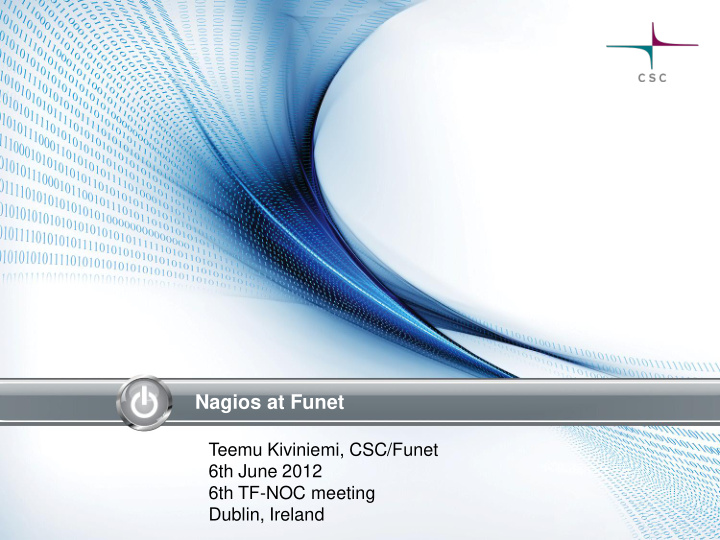



Nagios at Funet Teemu Kiviniemi, CSC/Funet 6th June 2012 6th TF-NOC meeting Dublin, Ireland
Introduction Funet uses Nagios extensively for monitoring. – network – servers – services Two Nagios monitoring servers – Over 900 monitored hosts – Over 10000 monitored services 2
Nagios at Funet NOC NOC follows the (combined) hostgroup and servicegroup summaries – Traditional and iPad versions are available. NOC receives SMS and/or e-mail alerts about critical services. NOC opens a ticket about each problem. Problems are acknowledged in Nagios with the ticket number. Nagios scheduled downtime is set before maintenance. 3
NOC monitoring levels We have four different monitoring urgency levels for our services. Monitoring levels have different reaction time requirements: – 30 minutes, 4 hours, NBD, best effort Also the operative processes and the documentation available to NOC must be better in services at higher monitoring levels. 4
NOC monitoring levels (continued) Monitoring levels have different notification options. Services at the highest monitoring level trigger SMS alerts to NOC immediately. No e-mail or SMS alerts are sent about best effort services. Nagios host and service escalations are defined to escalate longer service disruptions to managers. 5
Nagios configuration management Nagios configuration is split to several directories and files. Some configuration is identical between the two monitoring servers. Configuration files are in Subversion VCS. Service administrators configure service checks mostly on their own, following the agreed guidelines. 6
Automatically generated configuration Large parts of Nagios configuration are generated automatically. – Linux servers, routers, DWDM, switches, DNS zones. Configuration is generated with Perl scripts, and Nagios is updated automatically. Linux server administrators can customize some aspects of the generated configuration. 7
Custom check plugins We have written a lot of custom check plugins for our monitoring needs. A total of 85 custom Nagios check plugins are enabled in our current configuration. Examples: – BGP route status and other router/switch SNMP checks – IPv6 transition mechanisms – DNS zone SOA reachability – RRD statistics 8
Reporting We plot Nagios performance data using pnp4nagios. For all other reporting we use Nagios- Surfer – a tool developed at Funet. 9
How Nagios-Surfer works 10
Nagios configuration overview reports Generated by Nagios-Surfer for all hosts, services, contacts, and groups. Reports contain information about – Service checks - What is monitored and how? – Notifications - Who received notifications and when? – Configuration differences – What differences are there between the monitoring configuration of hosts or services in the same group. 11
Nagios configuration overview reports 12
Nagios availability reports Nagios-Surfer generates availability reports of all hosts, services, contacts and groups. Availability reports are pregenerated. – Unlike Nagios avail.cgi which reads through the event log each time a report is requested. – We get 1.5GB of event log per month. Availability numbers are reported per- month. 13
Nagios availability reports 14
Nagios event log reports Nagios-Surfer generates monthly event log summaries of all hosts and services. – Redundant information, such as duplicate and subsequent OK lines are removed. Each break contains a link to detailed information about the break. Event logs can be accessed easily through the availability reports. 15
Nagios event log reports 16
Nagios and quality assurance We have internal quality assurance processes that oversee that services meet the set reliability requirements. Service administrators investigate new service breaks and save the information to Nagios-Surfer. – A quality assurance process can use the data to concentrate on the most relevant issues. 17
Archiving information about breaks Information about the causes of all breaks is archived with Nagios-Surfer. Investigating old issues becomes easier, as the breaks of possible service dependencies are visible. Makes it easier to notice patterns. 18
Gathering detailed information about Nagios breaks Nagios-Surfer sends break clarification requests to administrators by e-mail. Administrators can categorize and describe breaks. The information is saved to Nagios-Surfer database for later use. If a break is categorized as scheduled downtime, the change will be reflected in the availability reports. – If a break happens during Nagios scheduled downtime, the break is automatically categorized as scheduled downtime. 19
Gathering detailed information about Nagios breaks 20
Providing availability reports to end- user organizations An organization connected to Funet will be able to see the availability history of all used services at a glance. – IP connections – Light paths – … and more? Availability data is provided by Nagios- Surfer. Work in progress 21
Some other useful tools A tool for scheduling Nagios downtime according to predefined templates. – Server X is rebooted – affects also services Y and Z. – Scheduled downtime is set for all affected services. A tool which combines several Nagios service groups into one large service group. 22
Performance Our primary monitoring server is a quad- core Xeon with 12GB of RAM and Ubuntu 10.04 LTS. Nagios keeps up with the monitoring schedule. Occasionally we have seen bad interactivity on the server, caused by massive disk I/O. – Especially when writing the state retention file – Nagios status files and object cache are now stored on tmpfs. 23
Things to improve Our high resolution end-user site ping monitoring is done outside Nagios. Nagios polls the status of end-user sites periodically, from the extenal monitoring system. New problems are seen by Nagios only after the next service check. – It would be better to push state changes to Nagios immediately. NOC would not have to look at two different monitoring screens. 24
Things to improve (continued) We have still some legacy monitoring that is done with custom-made scripts. We would like to integrate all our monitoring to Nagios. – We could use the same reporting for all our monitored services. – We could have a single NOC monitoring screen. 25
Conclusions Nagios suits us well. Nagios is easy to customize. – Has allowed us to modify and build on the available features. On the other hand, switching away from Nagios would be a lot of work now. 26
Recommend
More recommend